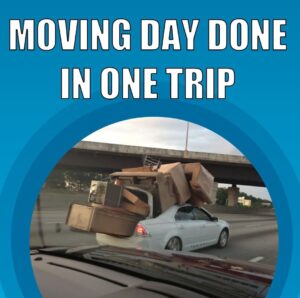
Oct
Opening a container to discover cracked dishes, damaged electronics, or any other kind of damage may spoil your entire day, as if moving wasn’t already stressful enough, having unprofessional movers is worse.
Who exactly is in charge of the mess? It’s probably your mover’s fault, although it isn’t a strict rule. Several distinct elements affect it.
The better moving companies, at least, have insurance. That safeguards both you and them.
From the mover’s perspective, it protects their company from ruin in the event of a significant lawsuit.

Accidents do occur. It offers you compensation in the event of a loss or damage.
Here’s how to decide who should foot the bill when something is damaged during a disastrous household move: you or your mover.
Let’s examine the question of whether moving companies are accountable.
Harm to the house
The mover is typically held liable for any damage to the house, whether it is the one you are moving to or from. Long workdays, awkward boxes, and heavy furniture can all result in dented drywall or a scratch on the floor.
Take pictures of your house to document its condition before moving day. There will be no doubt as to who caused the damage and who should pay to have it fixed if it is noticeable before or after the movers arrive.
Caution: If the damage was inevitable, movers might not be liable. For instance, a wobbly handrail or stair tread could trip a mover, force them to lose a nightstand, and eventually punch a hole through the drywall.
Damage to Your Property
You anticipate finding everything inside in the exact same condition it was packed when movers pick up your precious items and transfer them to their new home. Unfortunately, accidents do occur. Inside a moving container, all sorts of mischief can occur, including glasses breaking, lampshades bending, and more.
It may come down to one person packing the box when determining who is to blame for damage to packaged contents. You shouldn’t be held accountable for damage that occurred during transportation if all of your belongings were packed by movers.
They might not be held accountable, though, if you packed the boxes and the movers just picked them up.

Warning: You may have a case for payment if you packed a box and the movers plainly damaged it. However, look out for a “hold harmless” clause or a liability release with sweeping language in the moving contract. This statement is meant to safeguard the mover in all circumstances, at the very least if the client had packed their own stuff.
Even if these clauses don’t always hold up in court, if you agreed to the terms of the agreement, it can be harder for you to get your money back.
Taking Care of Yourself
Making a preliminary inventory of your possessions and taking photographs of them is one of the most crucial things you can do to safeguard yourself against loss. In between the point of origin and destination, a carton might occasionally vanish.
Again, mishaps occur. And occasionally a treasured item breaks.
An inventory and pictures are the only ways to demonstrate the existence of a carton and the state of your possessions. Fortunately, there are a number of moving applications available on the market that make it simple and combine itemization and photo functionality.
In the absence of that, a spreadsheet and digital images or a straightforward ledger with pictures will suffice.
Making a Claim
In the worst case scenario, you might be left with little choice except to make a claim once your relocation is over. According to My Moving Reviews, you could not get paid the full worth of the damaged item. However, your odds improve as you supply more details. Since most movers employ a uniform form, the procedure shouldn’t be challenging. How to do it is as follows:
Report any damage to the mover immediately away.
Assemble proof of the damage. Don’t toss anything out and take shots instead.
The mover’s claim form should be completed as quickly as feasible. You have nine months to file, according to My Moving Reviews, but the earlier the better.
Include pictures along with information on the damaged item, its inventory number, how it was damaged (was it dropped? ), whether the packing was also destroyed, the price you paid for the damaged item, and its worth on the day it was damaged.

Until the claim is resolved, keep the damaged item.
Give the same details to the best of your ability if the item has shown up missing.
Responsible work and careful transportation are hallmarks of reputable movers.
Verify each mover’s credentials, including their insurance and license, before hiring them.
Additionally, keep an eye out for damage-related complaints on Angie’s List, the Better Business Bureau, and other review sites.
Moving is rarely straightforward and never easy. One dropped box has the power to ruin everyone’s mood. But if you keep good records, you can make a compelling case for compensation.
Movers are aware that harm can occur, and they are prepared to take responsibility for it if they are held accountable.
Are professional movers on your radar?
Give White Glove a hand. By submitting a price request today, we’ll put you in touch with vetted, experienced movers who will handle your items with care.
